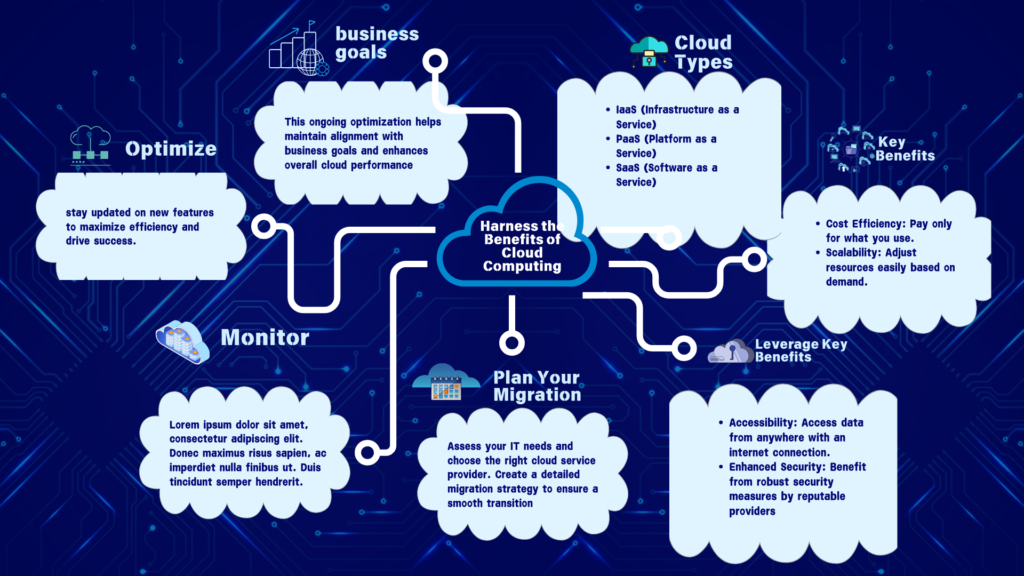In today’s fast-paced digital world, cloud computing has become a game-changer for businesses and individuals. It offers flexibility, scalability, and cost savings that traditional computing methods can’t match. But how do you harness these benefits? In this blog, we’ll explore the ins and outs of cloud computing and provide actionable insights on how to make it work for you.

What is Cloud Computing?
Before diving into the benefits, let’s clarify what cloud computing is, cloud computing allows you to store and access data and applications over the internet instead of on your local computer or server. Moreover, This means you can access your files from anywhere as long as you have an internet connection.
Types of Cloud Computing Services
There are three main types of cloud services:
- Infrastructure as a Service (IaaS): Firstly, This provides virtualized computing resources over the internet. Companies can rent servers, storage, and networking without investing in physical hardware.
- Platform as a Service (PaaS): Secondly, This offers a platform allowing developers to build, deploy, and manage applications without worrying about the underlying infrastructure.
- Software as a Service (SaaS): Thirdly This delivers software applications over the internet on a subscription basis. Examples include Google Workspace and Microsoft 365.
Understanding these types will help you choose the right service for your needs.
The Benefits of Cloud Computing
Now that we’ve established what cloud computing is, let’s explore its benefits. These advantages can significantly impact how you operate your business or manage your tasks.
1. Cost Efficiency
Firstly, One of the most appealing benefits of cloud computing is cost efficiency. Traditional IT infrastructure requires significant investment in hardware and maintenance. Then, With cloud services, you pay only for what you use. This pay-as-you-go model helps reduce capital expenses.
Example:
Consider a startup that needs to scale quickly. Instead of purchasing expensive servers, they can use cloud services to scale their operations without breaking the bank.
2. Scalability of cloud computing
Secondly, Scalability is another major advantage. As your business grows, so do your IT needs. Cloud services allow you to easily scale up or down based on demand.
Example:
A retail company may experience spikes in traffic during holiday seasons. With cloud computing, they can quickly increase their resources to handle the surge and then scale back down afterward.
3. Accessibility of cloud computing
Thirdly, Cloud computing offers unparalleled accessibility. You can access your data from anywhere with an internet connection. This flexibility is crucial for remote work and collaboration.
Example:
Imagine a team working on a project from different locations. Moreover, they can all access the same files in real-time, making collaboration seamless and efficient.
4. Enhanced Security of cloud computing
Fourthly, Security is often a concern when it comes to storing data online. However, reputable cloud service providers invest heavily in security measures. They offer encryption, firewalls, and regular security updates to protect your data.
If you want to read How to Connect HP Printer to Wi-Fi, You Need to Know Click Here
Example:
A healthcare organization must comply with strict regulations regarding patient data. Additionally, By using a secure cloud service, they can ensure compliance while protecting sensitive information.
5. Automatic Updates
Moreover, With cloud computing, software updates are automatic and seamless. You don’t have to worry about manually installing updates or patches.
Example:
If you use a SaaS application like Salesforce, you have access to the latest features without any downtime or extra effort.
6. Disaster Recovery
Additionally, Data loss can be catastrophic for any business. Cloud computing offers robust disaster recovery solutions that ensure your data is backed up and recoverable in an emergency.
Example:
A small business experiences a hardware failure but has data backed up in the cloud. They can quickly restore operations without significant downtime.
How to Get Started with Cloud Computing
Now that we’ve covered the benefits, let’s discuss how you can start with cloud computing.
Step 1: Assess Your Needs
Firstly, Begin by assessing your current IT needs and future goals. Consider factors like:
- What applications do you currently use?
- How much storage do you need?
- What level of security is required?
This assessment will help you determine which type of cloud service is best for you.
Step 2: Choose the Right Cloud Service Provider
Secondly, Research various cloud service providers to find one that meets your needs. Look for providers that offer:
- Reliable uptime
- Strong security measures
- Good customer support
- Flexible pricing plans
Some popular options include Amazon Web Services (AWS), Microsoft Azure, and Google Cloud Platform (GCP).
Step 3: Plan Your Migration
Thirdly, Migrating to the cloud requires careful planning. Create a detailed migration strategy that includes:
- A timeline for migration
- Identification of critical applications
- Training for employees on new systems
Involve all stakeholders in this process to ensure a smooth transition.
Step 4: Implement Security Measures
Moreover, Before fully migrating to the cloud, implement necessary security measures. This may include:
- Setting up user permissions
- Enabling multi-factor authentication
- Regularly updating passwords
These steps will help safeguard your data from potential threats.
Step 5: Monitor Performance
Finally, Once you’ve migrated to the cloud, continuously monitor performance metrics such as:
- Uptime
- Response times
- User satisfaction
Regular monitoring allows you to identify issues early and optimize performance over time.
Best Practices for Using Cloud Computing
To maximize the benefits of cloud computing, consider these best practices:
1. Regular Backups
Firstly, Even though cloud services often provide backup solutions, it’s wise to implement your own backup strategy as well. Regularly back up critical data to another location to ensure redundancy.
2. Train Your Team
Secondly, Ensure that your team understands how to use the new systems effectively. Provide training sessions and resources so everyone feels confident navigating the cloud environment.
3. Optimize Costs
Thirdly, Keep an eye on your usage patterns to avoid unexpected costs. Use tools provided by your cloud service provider to monitor resource consumption and optimize spending accordingly.
4. Stay Updated
Fourthly, Cloud technology evolves rapidly. Stay informed about new features and updates from your provider so you can take full advantage of their offerings.
Conclusion cloud computing
Cloud computing offers numerous benefits that can transform how businesses operate and individuals manage their tasks. From cost efficiency and scalability to enhanced security and accessibility, the advantages are compelling.
these steps are outlined above, assessing your needs, choosing the right provider, planning migration carefully, implementing security measures, and monitoring performance.
Remember that successful adoption requires ongoing effort and adaptation to technology. Embrace this change with an open mind, and you’ll find that cloud computing meets your current needs and positions you well for future growth.
In summary, understanding how to leverage cloud computing is essential in today’s digital landscape. With careful planning and execution, you can enjoy all its advantages while minimizing risks, ultimately leading to greater efficiency and success in whatever endeavor you pursue!
